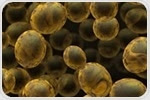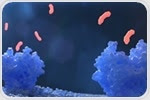|
| | October 7, 2019 | |
| | Biochemistry | |
| | The latest biochemistry news from AZoNetwork | |
|
|
 |
| |  What If NMR Was Easy? What If NMR Was Easy?
What if there was an NMR instrument everybody could operate, that was as easy to use infrared spectroscopy and as easy to interpret as mass spectrometry? Forget what you know and reimagine high-performance NMR spectroscopy in this webinar, taking place on October 8, 2019.
| |
|
|
|
|
 |
| | Interfacial Protein Monolayers are Strong Enough to Hold a Cell  Human cells adhere to extracellular matrices, such as modified cell culture dish surfaces, and stretch into specific shapes by crawling along the solid support. But how strong does a surface need to be so that the cells do not slip? Scientists from Japan have recently shown that a protein monolayer deposited on a liquid-liquid interface between water and a perfluorocarbon solvent is strong enough for human mesenchymal stem cells (hMSCs) to adhere and spread out. Human cells adhere to extracellular matrices, such as modified cell culture dish surfaces, and stretch into specific shapes by crawling along the solid support. But how strong does a surface need to be so that the cells do not slip? Scientists from Japan have recently shown that a protein monolayer deposited on a liquid-liquid interface between water and a perfluorocarbon solvent is strong enough for human mesenchymal stem cells (hMSCs) to adhere and spread out. | |
|
| | Structure and Function of Proteoglycans  Proteoglycans are ubiquitous molecules that function as critical components of the extracellular matrix. These proteins are composed of glycosaminoglycan chains that are covalently attached to a protein core. Even though just a handful of proteins have the propensity to become proteoglycans, their range of functions and potential roles in organism development is extremely broad. Proteoglycans are ubiquitous molecules that function as critical components of the extracellular matrix. These proteins are composed of glycosaminoglycan chains that are covalently attached to a protein core. Even though just a handful of proteins have the propensity to become proteoglycans, their range of functions and potential roles in organism development is extremely broad. | |
|
| | Smoking simulator captures synthetic cannabinoid combustion products  Researchers have developed a smoking simulator that enables the reliable detection of the combustion products formed when synthetic cannabinoids are smoked. These synthetic cannabinoids are a major class of new psychoactive substances that, once inhaled through smoking a conventional or electronic cigarette, may result in unknown combustion products with unknown biologic/toxic activity. Researchers have developed a smoking simulator that enables the reliable detection of the combustion products formed when synthetic cannabinoids are smoked. These synthetic cannabinoids are a major class of new psychoactive substances that, once inhaled through smoking a conventional or electronic cigarette, may result in unknown combustion products with unknown biologic/toxic activity. | |
|
| | Using Yeast to Produce Novel Cannabinoid Analogs  Researchers have successfully recreated the entire biosynthetic pathway for a range of major cannabinoids – including TCH and CBD in the yeast Saccharomyces cerevisiae. Manipulation of gene expression and enzyme promiscuity enabled the team to alter both the flux and activities of several pathways to produce both standard cannabinoids and rare analogs. Researchers have successfully recreated the entire biosynthetic pathway for a range of major cannabinoids – including TCH and CBD in the yeast Saccharomyces cerevisiae. Manipulation of gene expression and enzyme promiscuity enabled the team to alter both the flux and activities of several pathways to produce both standard cannabinoids and rare analogs. | |
|
| | Exploring the Structure-Activity Relationship (SAR) of Drugs  The structure-activity relationship (SAR) aids in understanding various aspects of drug discovery, from screening drug candidates to optimizing their properties. The effective biological activity is contributed by the various geometric and electrostatic interactions. The structure-activity relationship (SAR) aids in understanding various aspects of drug discovery, from screening drug candidates to optimizing their properties. The effective biological activity is contributed by the various geometric and electrostatic interactions. | |
|
| | CRISPR-Cas9 successfully reverses type 2 diabetes in mice  Researchers at Hanyang University, South Korea, have used the gene-editing technology CRISPR-Cas9 to treat obesity and type 2 diabetes in mice, a development that could eventually benefit humans. The therapy specifically reduced fat tissue and reversed obesity-related metabolic disease in the animals. Researchers at Hanyang University, South Korea, have used the gene-editing technology CRISPR-Cas9 to treat obesity and type 2 diabetes in mice, a development that could eventually benefit humans. The therapy specifically reduced fat tissue and reversed obesity-related metabolic disease in the animals. | |
|
|
|
|
































.png)











No hay comentarios:
Publicar un comentario